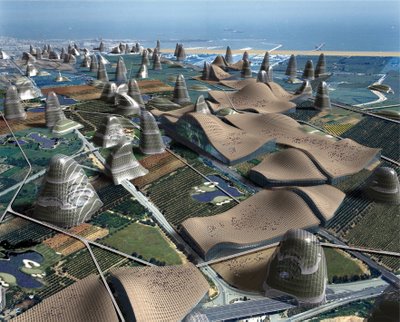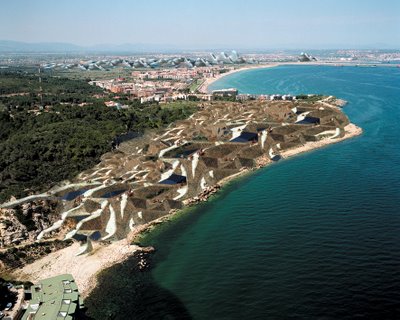The Transgondwanan Supermountain
 [Image: Vicente Guallart, a Barcelona-based architect whose work explores the mineralogical remaking of whole terrains – including how to make a mountain].
[Image: Vicente Guallart, a Barcelona-based architect whose work explores the mineralogical remaking of whole terrains – including how to make a mountain].Two articles have appeared in the last ten days or so about the impact of landscape on animal evolution.
In the first case, New Scientist reports, "one of the biggest mountain chains in the Earth's history may be responsible for the explosive diversification of animals more than 500 million years ago. Sediments washed from the mountains – dubbed the Transgondwanan Supermountain – added vital nutrients to the ocean, opening new evolutionary opportunities."
According to the theory's main advocate, Rick Squire – whose research interests include "tectonic processes affecting the early evolution of animals" – it was all a question of landscape, the geochemical erosion of super-topographies into biologically accessible micro-nutrients:
- [T]he trigger was the collision of a series of three large continental blocks – roughly corresponding to Arabia, India, and Antarctica – with the eastern edge of Africa from 650 to 515 million years ago. The drawn-out continental impact raised a vast 1000-kilometres-wide mountain range that stretched for more than 8000 kilometres along the equator on the ancient land mass known as Gondwana. Heavy rains typically fall along the equator, which would have produced a high level of erosion – it was before the evolution of land plants. Squire's research group has traced the resulting offshore sediment deposits around the world, and say they eventually amounted to more than 100 million cubic kilometres – enough to cover the entire US up to 10 kilometres deep.
Leading to a question for landscape architects: how could your urban park design affect the bodily structure of future organisms...?
 [Image: Vicente Guallart. Guallart's speculations about "how to make a mountain" include the following: "The geological structure of the hill, on the micro, the medium and the macro scales, offers us rules with which to put forward a mineralogical system that will guide its functioning." These are the internal rules of a landscape – and, Guallart implies, they can be reproduced architecturally].
[Image: Vicente Guallart. Guallart's speculations about "how to make a mountain" include the following: "The geological structure of the hill, on the micro, the medium and the macro scales, offers us rules with which to put forward a mineralogical system that will guide its functioning." These are the internal rules of a landscape – and, Guallart implies, they can be reproduced architecturally].Then there was an article published just yesterday about multi-million year extinction cycles in mammalian species, and how these cycles might actually be linked to "regular wobbles in Earth's orbit":
- Changes in the Earth's tilt and the shape of its orbit lead to climate cycles of around 1.2 and 2.4 million years. At their extremes both these cycles cause global cooling, expansion of polar ice sheets and changes in rainfall patterns. [Mammalian] extinction peaks coincided with global cooling maxima, while new appearance peaks coincided with periods of stable climate.
 [Image: Vicente Guallart. Guallart's terrestrial speculations continue: "The limestone of the hill and its rhombohedric crystals of calcite enabled us to conceive, at multiple scales, a crystalline genesis for the project." This thus forms a "coherent system, from the structure itself to its outer limit, that responds to a single system of crystallization. In this way, the skin, like soil in the hills, directly reflects the internal logic of the mass and its interaction with the environment." With these rules in place, Guallart says, his firm could make mountains].
[Image: Vicente Guallart. Guallart's terrestrial speculations continue: "The limestone of the hill and its rhombohedric crystals of calcite enabled us to conceive, at multiple scales, a crystalline genesis for the project." This thus forms a "coherent system, from the structure itself to its outer limit, that responds to a single system of crystallization. In this way, the skin, like soil in the hills, directly reflects the internal logic of the mass and its interaction with the environment." With these rules in place, Guallart says, his firm could make mountains]. Second of all, this intertwining – of plate tectonics, planetary rotation, large-scale topographical change, and the birth, death, and even wholesale pruning of genetic lines – surely has a place in landscape design courses. At the very least, a phenomenally great architectural pamphlet, or even course syllabus, could be written about the possibilities: artificial mountain chains spurring micro-speciation; gardens as centers of genetic novelty; even mega-earthworks and the architectural manipulation of continental drift.
Which makes me wonder, for instance, since single architectural projects are apparently enough to cause earthquakes, that perhaps architecture itself could be used to over-weight the earth and thus guide, or subtly control, its changing rotation... thus destroying all mammalian life on the planet. Terrestrial weaponization.
The next Bond villain.
Or print t-shirts: Architecture is killing us all.
(Similar thoughts appear toward the end of this post).





Comments are moderated.
If it's not spam, it will appear here shortly!
First of all, I like the idea of "new appearance peaks," or moments in planetary history when speciation hits a kind of mutational warp-speed, and even your own generation might be the quiet origin of a new species.
Otherwise known as punctuated equilibrium!
How much for a shirt?
I'd take one of those shirts, too. :) Is anyone actually doing quantitative research into the effect of mega-skyscrapers? I've always suspected that they can't be a good idea.
holy crap.
architects should stop trying to understand biology.
blargh.
Great advice. Thanks.
In keeping with the death theme, I'm waiting for the BLDBLOG series on deadly indoor mold.
Post a Comment